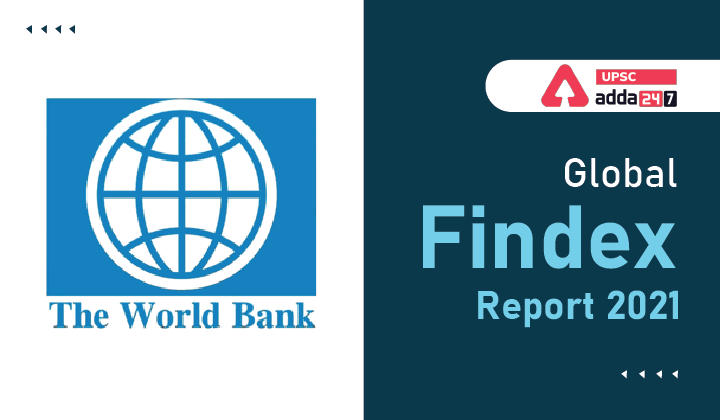Table of Contents
Global Findex Report : Relevance
- GS 2: Indian Economy and issues relating to planning, mobilization, of resources, growth, development and employment.
Global Findex Report : Context
- Recently, World Bank has released a new report titled, Global Findex Report 2021’, to provide a definitive source of data on global access to financially services from payments to savings and borrowing.
Global Findex Report : Key points
- The 2021 edition contains updated indicators on access to and use of formal and informal financial services and digital payments, and offers insights into the behaviours that enable financial resilience.
- The data also identify gaps in access to and usage of financial services by women and poor adults.
- The Global Findex Database is being published every three years since 2011 and has become an indispensable tool for policymakers, researchers, practitioners, media and the development community.
Global Findex Report : Key findings
- Evidence shows that households and businesses that have access to financial services are better able to withstand financial shocks than those that do not.
- Digital financial services such as mobile money let users safely and inexpensively store funds and transfer them quickly and affordably across long distances, which lead to higher remittances and consumption and more investments.
- For women, accounts can enable financial independence and strengthen economic empowerment.
- In India, PM Jan Dhan Yojana reached over 100 million people showing that paying women their benefits directly into their own account increased women’s financial control, influenced gender norms preventing women from working, and incentivized women to find employment, compared with those paid in cash.
Findings on account holders
- Globally, in 2021, 76 percent of adults had an account at a bank or regulated institution such as a credit union, microfinance institution, or a mobile money service provider.
- Account ownership around the world increased by 50 percent in the 10 years spanning 2011 to 2021, from 51 percent of adults to 76 percent of adults.
- Recent growth in account ownership has been widespread across dozens of developing economies. This geographic spread is in stark contrast to the growth seen from 2011 to 2017, which took place mostly in China or India
Findings on receiving payments
- In developing economies, the share of adults making or receiving digital payments grew from 35 percent in 2014 to 57 percent in 2021.
- In high-income economies, on the other hand, the share of adults making or receiving digital payments is nearly universal (95 percent).
Digital payments induced by COVID-19
- The share of adults making a digital merchant payment have increased after the outbreak of COVID-19.
- For example, in India more than 80 million adults made their first digital merchant payment during the pandemic.
Financially inexperienced users
- About two-thirds of unbanked adults said that if they opened an account (excluding mobile money) at a financial institution, they could not use it without help.
- Women are 5 percentage points more likely than men to need help using their mobile money account.
Read current affairs for UPSC





 TSPSC Group 1 Question Paper 2024, Downl...
TSPSC Group 1 Question Paper 2024, Downl...
 TSPSC Group 1 Answer key 2024 Out, Downl...
TSPSC Group 1 Answer key 2024 Out, Downl...
 Cabinet Ministers of India 2024, New Cab...
Cabinet Ministers of India 2024, New Cab...







